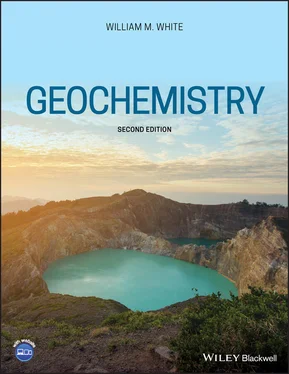We found the thermodynamic properties of solutions depend on their composition as well as T and P and to deal with this we introduced partial molar quantities, particularly the partial molar Gibbs free energy or chemical potential:(3.13)
The simplest solutions are ideal ones, where there are no energetic or volumetric effects of solution (ΔH = 0; ΔV= 0), so the enthalpy and volume of an ideal
solution are simply their sum of the partial molar quantities. There are, however, entropic effects associated with solution, so that(3.31)
In nonideal solutions, the availability of a species for reaction can differ from its concentration; to deal with this we introduced fugacity and activity; the latter is related to concentration through an activity coefficient:(3.48) The activity coefficient is related to the excess Gibbs free energy associated with nonideal behavior:(3.56a) Much of the problem with dealing with nonideal solutions is reduced to finding values for the activity coefficients.
Electrolyte solutions, of which seawater is a good example, are common nonideal solutions. We reviewed the nature of these solutions and introduced approaches for calculating activity coefficients in them, such as the Debye–Hückel extended law:(3.74) We then reviewed ways to calculate activities in ideal solid solutions.
In section 3.9, we introduced the equilibrium constant:(3.85) and found we could directly relate it to the Gibbs free energy of reaction.
In section 3.11, we introduced the electrochemical potential to deal with changing valance states of elements, that is, oxidation–reduction reactions. This too we could relate to our thermodynamic framework:(3.106) A useful way to represent redox potential in low-temperature systems is the electron activity(3.112) which we could also directly relate to electrochemical potential. Since oxygen is the most common oxidant, in high-temperature systems, the redox state of the system is more commonly represented with oxygen fugacity, ƒO2.
REFERENCES AND SUGGESTIONS FOR FURTHER READING
1 Anderson, G.M. and Crerar, D.A. 1993. Thermodynamics in Geochemistry. New York, Oxford University Press.
2 Blount, C.W. 1977. Barite solubilities and thermodynamic quantities up to 300°C and 1400 bars. American Mineralogist 62: 942–57.
3 Brookins, D.G. 1988. Eh-pH Diagrams for Geochemistry. New York, Springer Verlag.
4 Davies, C.W. 1938. The extent of dissociation of salts in water. VIII. An equation for the mean ionic activity coefficient in water, and a revision of the dissociation constant of some sulfates. Journal of the Chemical Society 2093–8.
5 Davies, C.W. 1962. Ion Association. London, Butterworths.
6 Debye, P. and Hückel, E. 1923. On the theory of electrolytes. Phys. Z. 24: 185–208.
7 Fletcher, P. 1993. Chemical Thermodynamics for Earth Scientists. Essex, Longman Scientific and Technical.
8 Garrels, R.M. and Christ, C.L. 1965. Solutions, Minerals, and Equilibria. San Francisco: Freeman Cooper.
9 Helgeson, H.C. 1967. Solution chemistry and metamorphism, in Researches in Geochemistry vol. 2 (ed. P.H. Abelson), pp. 362–402. New York, John Wiley and Sons, Ltd.
10 Helgeson, H.C. and Kirkham, D.H. 1974. Theoretical prediction of the thermodynamic behavior of aqueous electrolytes at high pressures and temperatures, Debye–Hückel parameters for activity coefficients and relative partial molar quantities. American Journal of Science 274: 1199–261.
11 Helgeson, H.C. and Kirkham, D.H. 1976. Theoretical prediction of the thermodynamic properties of aqueous electrolytes at high pressures and temperatures. III. Equation of state for aqueous species at infinite dilution. American Journal of Science 276: 97–240.
12 Kerrick, D.M. and Jacobs, G.K. 1981. A modified Redlich–Kwong equation for H2O, CO2 and H2O–CO2 mixtures at elevated pressures and temperatures. American Journal of Science 281: 735–67.
13 Morel, F.M.M. and Hering, J.G. 1993. Principles and Applications of Aquatic Chemistry, 2nd edn. New York, John Wiley and Sons, Ltd.
14 Nordstrom, D.K. and Munoz, J.L. 1986. Geochemical Thermodynamics. Palo Alto, Blackwell Scientific.
15 Saxena, S.K., Chaterjee, N., Fei, Y. and Shen, G. 1993. Thermodynamic Data on Oxides and Silicates. Berlin, Springer Verlag.
1 Consider the following minerals:anhydrite:CaSO4bassanite:CaSO4.½H2O(plaster of Paris)gypsum:CaSO4.2H2OIf water vapor is the only phase of pure water in the system, how many phases are there in this system and how many components are there?How many phases are present at invariant points in such a system? How many univariant reactions are possible? Write all univariant reactions, labeling each according the phase that does not participate in the reaction.
2 Consider a system consisting of olivine of variable composition ((Mg,Fe)2SiO4) and orthopyroxene of variable composition ((Mg,Fe)SiO3). What is the minimum number of components needed to describe this system?
3 In section 3.2.1.3, we showed that a system containing , and OH– could be described in terms of components , H+, and OH–. Find a different set of components that describe the system equally well. Show that each of the species in the system is an algebraic sum of your chosen components.
4 Use the data in Table 2.2to construct a temperature–pressure phase diagram that showing the stability fields of calcite and aragonite.
5 Consider the following hypothetical gaseous solution: gases 1 and 2 form an ideal binary solution; at 1000 K, the free energies of formation from the elements are −50 kJ/mol for species 1 and −60 kJ/mol for species 2.Calculate ΔGmixing for the solution at 0.1 increments of X2. Plot your results.Calculate for an ideal solution at 0.1 increments of X2. Plot your results.Using the method of intercepts, find μ1 and μ2 in the solution at X2 = 0.2
6 Using the thermodynamic data in Table 2.2, determine which side of this reaction is stable at 600°C and 400 MPa.:
7 The following analysis of water is from the Rhine River as it leaves the Swiss Alps:Ca2+40.7 ppmHCO3–113.5 ppmMg2+7.2 ppmSO42–36.0 ppmNa+1.4 ppmNO3–1.9 ppmK+1.2 ppmCl−1.1 ppmCalculate the ionic strength of this water. (Recall that concentrations in ppm are equal to concentrations in mmol kg−1 multiplied by formula weight.)Using the Debye–Hückel equation and the data in Table 3.2, calculate the practical activity coefficients for each of these species at 25°C.
8 Seawater has the following composition:Na+0.481 MCl−0.560 MMg2+0.0544 MSO42–0.0283 MCa2+0.0105 MHCO3–0.00238 MK+0.0105 MCalculate the ionic strength.Using the Davies equation and the data in Table 3.2, calculate the practical activity coefficients for each of these species at 25°C.
9 The following is an analysis of Acqua di Nepi, a spring water from the Italian province of Viterbo:Ca2+82 ppmHCO3–451 ppmK+50 ppmSO42–38 ppmMg2+27 ppmCl−20 ppmNa+28 ppmNO3–9 ppmF–1.3 ppmCalculate the ionic strength of this water.Using the Debye–Hückel equation and the data in Table 3.1, calculate the practical activity coefficients for each of these species at 25°C.
10 Water from Thonon, France, has the following composition:Anionsmg/lCationsmg/lHCO3–332Ca2+103.2SO42_14Mg2+16.1NO3–14K+1.4Cl–8.2Na+5.1What is the ionic strength of this water?What are the activity coefficients for and in this water?Assuming an equilibrium constant for the dissociation of bicarbonate:of 4.68 × 10–11 and a pH of 7.3, what is the equilibrium concentration of in this water?
11 The equilibrium constant for the dissolution of galena:is 9.12 × 10−7 at 80°C. Using = 0.11 and = 1.77, calculate the equilibrium concentration of Pb2+ in aqueous solution at this temperature and at pHs of 6, 5 and 4. Assume the dissolution of galena is the only source of Pb and H2S in the solution, and that there is no significant dissociation of H2S. Hint: Mass balance requires that [H2S] = [Pb2+].
Читать дальше












